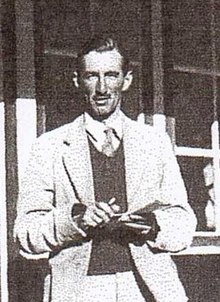黎吉生
黎吉生[1](英语:Hugh Edward Richardson,1905年12月12日—2000年12月3日),英国圣安德鲁斯人,英国外交官、藏学家。其研究领域主要为吐蕃历史,尤其重视碑刻。他被称为“现代藏学之父”。[2][3]

生平
编辑黎吉生生于苏格兰圣安德鲁斯。格莱纳尔蒙学院毕业后到牛津大学基布尔学院学习古典学。1930年,他成为公务员,并于1936年至1940年、以及1946年至1947年作为英国驻拉萨代表团代表,1937年5月–11月代理上级的驻锡金政务官。印度于1947年独立后,他继续担任印度代表驻拉萨至1950年,在解放军入藏前几个月离开。在退休后,他回到圣安德鲁斯,余生从事私人研究工作。[4][5]
他是掌握多种语言的语言学家,孟加拉语流利得可以同泰戈尔交谈。他流利的藏语被西藏政治家夏格巴描述为“无可挑剔的拉萨藏语,带有轻微的牛津口音”。[6]
他主张西藏应当有权利成为一个单独存在的政治实体。他在两本书 Tibet and Its History (1962) 以及 A Cultural History of Tibet (1968)中均谈到了这一主张,并在爱尔兰在联合国提出中国压迫西藏问题时在联合国提出了这一主张。在联合国,用一位评论家的话来说,“他作为一位诚实的人勇敢从事于很大程度上已被遗忘的事业,因为出于政治上的权宜之计,双方都不顾原则并且不愿冒险倾向于可能的失败方,但他这样做值得。”据报道,他的立场引起了英国和印度出席联合国大会代表团的不满。[7]
后来他写道,“英国政府,这西方国家中唯一与西藏有条约关系的政府,将西藏抛入深渊并从此不断冷落西藏人,结果1959年他们甚至没有支持联合国谴责中国人在西藏侵犯人权的决议。(The British government, the only government among Western countries to have had treaty relations with Tibet, sold the Tibetans down the river and since then have constantly cold-shouldered the Tibetans so that in 1959 they could not even support a resolution in the UN condemning the violation of human rights in Tibet by the Chinese.)”
黎吉生也曾说他“深感羞愧(profoundly ashamed)”[8],不仅因为英国政府不支持西藏享有自决权,而且也因为英国政府对待十四世达赖喇嘛的态度。[9]
1999年,黎吉生获得国际声援西藏运动颁发的真理之光奖,表扬他对于藏学的贡献,以及作为外国第一位驻西藏的外交使节。[10]
著作
编辑中译本
编辑- 黎吉生. 《西藏简史》. 李有义译. 中国社会科学院研究所. 1979. OCLC 298721613.
英文
编辑- 1949 “Three ancient inscriptions from Tibet” Journal of the Royal Asiatic Society of Bengal 15, (1949): 45-64.
- 1952. Ancient historical edicts at Lhasa and the Mu Tsung / Khri Gtsung Lde Brtsan treaty of A.D. 821-822 from the inscription at Lhasa. London: Royal Asiatic Society Prize Publication Fund 19, 1952.
- 1952-3 “Tibetan inscriptions at Zva-hi Lha Khang” London: Journal of the Royal Asiatic Society, (1952): 133-54 (1953): 1-12.
- 1954 “A ninth-century inscription from Rkong-po.” Journal of the Royal Asiatic Society. London, (1954): 157-73.
- 1957 “A Tibetan Inscription from Rgyal Lha-khang” Journal of the Royal Asiatic Society London, (1957): 57-78.
- 1964 “A new inscription of Khri Srong Lde Brtans.” Journal of the Royal Asiatic Society London. (1964): 1-13.
- 1965a "How old was Srong-brtsan Sgam-po ?", Bulletin of Tibetology, vol. 2, no. 1, 6-8. Repr. in Richardson 1998: 3-6.
- 1965b "A fragment from Tun-huang", Bulletin of Tibetology, vol. 2, no. 3, 33-38. Repr. in Richardson 1998: 7-11.
- 1968 with David Snellgrove. A Cultural History of Tibet. 1995 2nd Edition with changes. Shambhala. Boston & London. ISBN 1-57062-102-0.
- 1969 “The inscription at the Tomb of Khri Lde Srong Btsan”, Journal of the Royal Asiatic Society (1969): 29-38
- 1969b “Tibetan chis and tschis.” Asia Major 14 (1969): 154-6.
- 1972 “The rKong-po Inscription.” Journal of the Royal Asiatic Society London. (1972): 30-39.
- 1973 “The Skar-cung inscription.” Journal of the Royal Asiatic Society. (1973): 12-20.
- 1974 Ch'ing Dynasty Inscriptions at Lhasa. (Serie Orientale Roma v. 47). Rome: Instituto italiano per l'africa e l'oriente. 1974.
- 1978 “The Sino-Tibetan treaty inscription of A.D. 821/823 at Lhasa.” Journal of the Royal Asiatic Society: (1978): 137-62.
- 1983 “Bal-po and Lho-bal” Bulletin of the School of Oriental and African Studies 46 (1983): 136-8.
- 1985. A corpus of Early Tibetan Inscriptions. (James G. Forlong Series no. 29). Hertford: Royal Asiatic Society, 1985. ISBN 0-947593-00-4.
- 1987 “Early Tibetan Inscriptions: Some Recent Discoveries” The Tibet Journal 12.2.Dharamsala: Library of Tibetan works and archives, (1987): 3-15. (reprinted with 2 short notes added) Bulletin of Tibetology n.s. 3. Gangtok Sikkim Research Institute of Tibetology, (1987): 5-18. High Peaks, Pure Earth. London: Serindia, 1998: 261-275.
- 1988 “More Early Inscriptions from Tibet” Bulletin of Tibetology. New Series 2. Gangtok Sikkim Research Institute of Tibetology. (1988): 5-8. High Peaks, Pure Earth. London: Serindia, 1998: 276-278.
- 1989 "Eary Tibetan law concerning dog-bite", Bulletin of Tibetology, new ser. 3, 5-10. Repr. in Richardson 1998: 135-139.
- 1990 "Hunting accidents in early Tibet", Tibet Journal, 15-4, 5-27. Repr. in Richardson 1998: 149-166.
- 1995a “The Tibetan Inscription attributed to Ye shes ‘od” Journal of the Royal Asiatic Society. 3rd Series 5.3. (1995): 403-404.
- 1995b “The inscription at Ra-tshag Dgon-pa” Bulletin of the School of Oriental and African Studies 58 (1995): 534-9; High Peaks, Pure Earth. London: Serindia, 1998: 286-291.
- 1997 Adventures of Tibetan Fighting Monk with Khedrup Tashi, White Orchid Books; ISBN 974-87368-7-3, Orchid Press, 2006, ISBN 974-8299-17-1
- 1998 High peaks, pure earth: collected writings on Tibetan history and culture, Serindia publications, London.
注释
编辑- ^ 中英關於取消英國在華治外法權及有關特權條約. 全国法规资料库.
- ^ Hugh Richardson (1905-2000) (页面存档备份,存于互联网档案馆), Pitt Rivers Museum, Oxford
- ^ Alex Mckay. Richardson Hugh: High peaks, pure earth: collected writings on Tibetan history and culture. Edited by Aris Michael. [xxi], 776 pp., 64 plates. London: Serindia, 1998. £25.. Bulletin of the School of Oriental and African Studies (School of Oriental and African Studies, University of London). June 1999, 62 (2): 384–385. doi:10.1017/S0041977X00017201.
- ^ Hugh Richardson. The Guardian. 2001-01-04 [2017-10-24]. (原始内容存档于2017-10-24).(英文)
- ^ Bill Peters. Hugh Richardson, CIE, OBE. Asian Affairs. 2001, 32 (2): 252–253 [2018-06-23]. (原始内容存档于2022-03-19).
- ^ Our Last Man In Lhasa, He Brought Unrivalled Knowledge Of Tibet To Warnings Of Chinese Ambitions. [2012-08-10]. (原始内容存档于2012-02-08).
- ^ Obituary -- Dr Hugh Richardson. [2012-08-10]. (原始内容存档于2012-02-08).
- ^ French 2003
- ^ My Direct Experience of Independence Tibet 1936-49. [2012-08-10]. (原始内容存档于2008-03-22).
- ^ Danielle Mitterrand, Hugh Richardson and Richard Blum to receive ICT’s Light of Truth Awards. 国际声援西藏运动. 1999-10-04 [2017-10-27]. (原始内容存档于2017-10-28).(英文)
参考文献
编辑- Hugh Richardson (1905-2000) (页面存档备份,存于互联网档案馆), Pitt Rivers Museum, Oxford
- Tibetan Studies in Honour of Hugh Richardson. Edited by Michael Aris and Aung San Suu Kyi, p. 284. (1979). Vikas Publishing house, New Delhi.
- French, Patrick. Tibet, Tibet: A Personal History of a Lost Land (2003) Knopf. ISBN 1-4000-4100-7
外部链接
编辑- 黎吉生著作High Peaks, Pure Earth的摘要 (PDF). 自由亚洲电台. [2017-10-28]. (原始内容存档 (PDF)于2017-06-26).(英文)